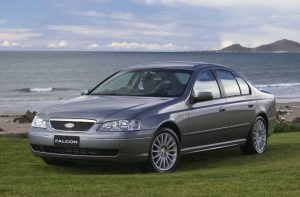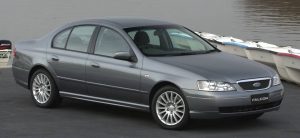Recalls: Ford BA Fairmont
Overview
Manufacturers, or importers, issue recalls for defects or faults which have the potential to cause injury. Generally, manufacturers will inform the original buyers if their vehicle is subject to a recall and of the steps required to remedy the defect or fault. Please note that the number of recalls should not be taken as an indicator of a model’s reliability or its safety more generally.
Recalls: Ford BA Fairmont
- In October 2002, a recall was issued for Ford BA Fairmont sedans fitted with the 4.0-litre inline six cylinder engine and manufactured from 5 September 2002 to 3 October 2002 inclusive. For these vehicles, the inner CV joints of the IRS half shafts fitted to certain models may have been assembled without a retaining circlip – this may allow the half shafts to move away from the inner CV joint and become disengaged (PRA 2002/5759).
- In November 2002, a recall was issued for Ford BA Fairmont models fitted with front side airbags manufactured up to 1 November 2002 (inclusive). In these vehicles, the discharge of static electricity may cause the side airbags to inadvertently deploy when a person is alighting either the passenger or driver’s side front seats (PRA 2002/5825).
- In February 2011, a recall was issued for Ford BA and BF models built from 8 May 2002 to 7 March 2008 and with a factory-fitted sunroof. In these vehicles, a bonding problem with the sunroof’s glass panel could result in separation from the frame and potentially dislodge while the vehicle was in motion (PRA 2011/12318).
Problems and faults: Ford BA Fairmont
Overview
This section identifies potential problems, causes and fixes based on the experiences of owners and repairers, online sources and technical service bulletins. This information is provided solely for reference purposes and AustralianCar.Reviews recommends that only properly qualified persons carry out repairs or modifications. Furthermore, the number of items below should not be taken as an indicator of a model’s reliability or the frequency with which they may occur.
To report a problem or fault to the AustralianCar.Reviews team, please use the Contact Us form. Note that AustralianCar.Reviews does not offer advice on automotive problems or disputes; such enquiries will not receive a reply. For vehicles purchased from dealers after 1 January 2011, please see our Australian Consumer Law fact sheet.
Engines
- Belt squeal and rattling noises from the engine bay may be due to a faulty accessory belt tensioner which requires replacement. If the tensioner fails, the accessory belt may snap, causing the power steering, alternator and water pump to stop working.
- A rattling noise at idle may be due to a loose exhaust heat shield.
- The radiator was susceptible to leaking.
- The O-ring seal at the back of the water pump was susceptible to leaking.
- Low idle, stall or variable idle: for Ford’s BA/BF vehicles, engine speed may drop below the normal idle speed – the engine may then either stall or the ECU may intervene to raise engine speed, causing a variable idle. Ford Australia issued a service bulletin (TSB 20/05) regarding this problem recommending that the throttle body be cleaned and the ECU re-flashed.
- Knocking noises from the engine bay which are loudest near the glovebox may be due to the vacuum hoses vibrating against the body or other components – this can be fixed with a cable-tie.
Barra 220 V8 engine: chain tensioners and rattling on start-up
The Barra 220 V8 engine was initially fitted with plastic chain tensioners. Over time, the plastic chain tensioners would wear out and lose tension, causing a rattling noise on start-up (see video below) and oil to drain out. It is understood that metal chain tensioners were introduced late in the production of the Ford BA Mk II.
Transmission
- Four-speed BTR automatic transmission: the transmission cooler was located in the radiator and the cooling lines were susceptible to failure due to age, wear or corrosion. If this occurred, the fluid in the coolant reservoir would appear milky (hence the term ‘milkshake’) and damage to the transmission would require it to be rebuilt or replaced. To prevent contamination of the transmission fluid with coolant, a common modification was to fit an external air/oil transmission cooling kit which bypassed (and sealed) the cooler in the radiator.
- Difficulty selecting gears may be due to a loose gear selector linkage/mechanism.
Steering shudder
In December 2004, Ford Australia issued a technical service bulletin (TSB 98R/04) for Ford BA vehicles with six-cylinder engines due to fluid pulsations in the power steering system causing the steering wheel to shudder – this generally occurred during low speed manoeuvres like parking. To fix, the power steering system was to be bled; if that did not fix the problem, a new high-pressure power steering hose was to be fitted and the system bled.
Rear brake hose service campaign
In May 2007, Ford Australia initiated a ‘service campaign’ to replace the rear brake hoses of 200,000 Ford BA/BF vehicles that were produced from September 2002 to March 2007. In these vehicles, the rear brake hoses were susceptible to excessive wear and could leak. At worst, however, the hoses could rupture. While the river would generally experience reduced braking effectiveness and a warning light would illuminate in the instrument cluster, drivers have reported a complete loss of braking that required the handbrake to be deployed to slow the vehicle. As part of the service campaign, the brake hoses were replaced during regular servicing performed by Ford dealers.
Brakes
- Shuddering from the front wheels – which can be felt through the brake pedal – is indicative of warped brake discs.
- Squealing noises from the brakes may be due to brake pad glazing (i.e. the friction material overheats on the pad surface and disc). Brake pad glazing may also result in increased stopping distances, brake shudder and vibrations.
- The ABS light may illuminate intermittently due to problems with the ABS sensors – this may be fixed by cleaning or replacing the sensors.
Handbrake
For Ford BA/BF sedans, the handbrake shoe may not centre correctly when the handbrake is released due to the fixed end not holding the show in position – this may cause a ‘cyclic swish type noise’ from the driver’s side rear wheel when driving. Ford Australia issued a technical service bulletin (TSB 09/06) regarding this problem and developed a kit (BA2 2K068 AKIT) to fix whereby a revised park brake shoe centering spring would be fitted and the contact points lubricated.
Suspension
- Knocking noises from front suspension may be due to worn lower ball joints.
- Clunking noises from the rear of the vehicle – particularly at low speeds – may indicate that the differential bushes require replacement. For a batch of vehicles produced from 2002 to late 2003, the differential itself was replaced under warranty.
- Knocking noises from the rear suspension when driving over bumps may indicate that the upper shock bushes require replacement.
- For noisy rear shock absorbers, a technical service bulletin was issued due to the bolts being incorrectly torqued on some 2003 models.
Problems and faults: Ford BA Fairmont
- A malfunctioning body computer may turn on the interior lights and drain the battery; if so, the computer needs to be reset.
- Problems with the door locks are usually due to the actuators failing.
- Low battery voltage can make the gearshift indicators flash and the transmission enter ‘limp home’ mode, requiring the battery to be replaced.




